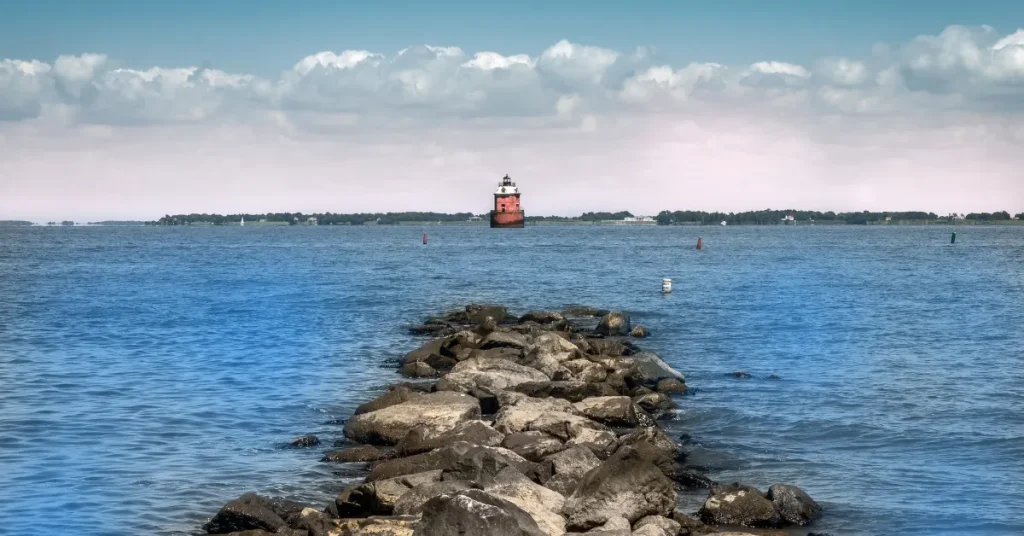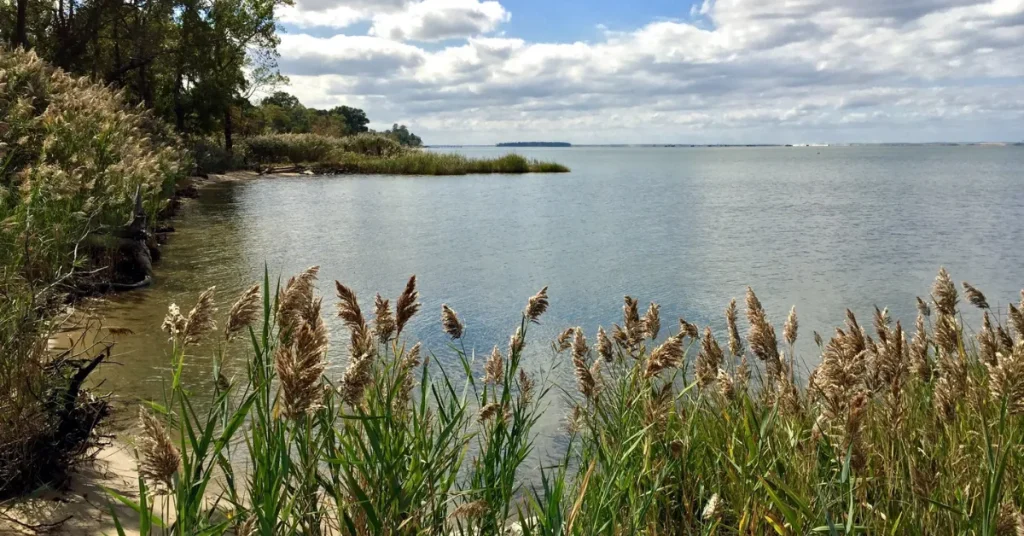The Chesapeake Bay spans approximately 200 miles in length and varies in width. Its narrowest point is about 2.8 miles wide, while its widest point reaches up to 30 miles.
Discover the natural wonder that is the Chesapeake Bay, a gem nestled on the East Coast of the United States. This majestic body of water stands as the largest estuary in the country, offering an essential habitat for diverse wildlife and serving as a pivotal resource for local industries.
Rich with history and surrounded by scenic landscapes, the bay supports numerous activities, from sailing and fishing to tourism and research.
The diverse width of the Chesapeake Bay provides a unique set of ecosystems and environmental conditions that contribute to its ecological variety.
Travellers and nature enthusiasts alike flock to its shores to experience the harmonious blend of picturesque beauty and vibrant communities, all of which rely on the bay’s health and sustainability.

The Lure Of The Chesapeake
The Chesapeake Bay, with its vast expanse and serene beauty, beckons adventurers and dreamers alike. This majestic bay, known for its remarkable width and ecological wonders, is a place where history whispers from the shoreline and modern attractions dazzle visitors.
The awe-inspiring bay stretches wide, inviting exploration and offering a unique blend of natural and cultural experiences.
Attractions Alongside The Waters
Every turn along the Chesapeake Bay’s shoreline reveals a treasure trove of sights. Tourists and locals delight in a myriad of activities:
- Maritime Museums: They narrate the story of the bay’s nautical heritage.
- Lighthouses: Historic beacons that have guided sailors for centuries.
- Waterfront Parks: Perfect for picnics, hikes, and family fun.
- Seafood Festivals: Where the day’s catch turns into a celebratory feast.
- Boating and Fishing: Skim across the waters or cast a line for the big one.
Beyond these, countless local galleries, boutique shops, and charming bed-and-breakfast inns dot the scenic coastline, ensuring visitors find their own slice of bay life to cherish.
Historical Significance Of The Bay
Chesapeake Bay is not only a natural wonder but also a capsule of American history. The bay witnessed key moments:
- Original Native American settlements that thrived on these lands.
- Arrival of European settlers, changing the course of history.
- Battles fought on its waters, shaping the nation’s story.
Evidence of the past lives on in colonial towns, civil war forts, and museums that safeguard the bay’s saga.
Each site offers a chance to step back in time and walk in the footsteps of ancestors. Engaging interpretive programs bring history to life for visitors of all ages.
Physical Expanse Of The Chesapeake

The Chesapeake Bay is a marvel of nature. It stretches majestically across the Eastern United States.
Its size commands attention, inviting a closer look at its physical dimensions. From its scenic inlets to the wide-open brackish waters, the Chesapeake Bay holds secrets of size awaiting discovery.
Measuring The Bay’s Width
To understand the sheer size of the Chesapeake Bay, we must pinpoint its width. It varies vastly from north to south. The narrowest point is near Aberdeen, Maryland, measuring roughly 2.8 miles across.
In contrast, the widest part is near the mouth of the bay, stretching up to 30 miles wide. These figures offer perspective on its expansive reach.
- Narrowest Point: Near Aberdeen, MD – approximately 2.8 miles
- Widest Point: Near the bay’s mouth – up to 30 miles
Comparison To Other Notable Bodies Of Water
The Chesapeake Bay’s width is not easily forgotten. When compared to other famous waters, its size stands out. For instance, Lake Tahoe, a large freshwater lake, has a maximum width of about 12 miles, much narrower than the Bay’s widest point.
San Francisco Bay, also renowned for its size, reaches up to 12 miles at its widest, a stark contrast to the Chesapeake’s 30-mile expanse. Such comparisons highlight the Chesapeake Bay’s significant place among America’s great waters.
| Body of Water | Maximum Width (miles) |
| Chesapeake Bay | 30 |
| Lake Tahoe | 12 |
| San Francisco Bay | 12 |
These comparisons paint a clear picture of the Bay’s grandeur in the landscape of American waters. The Chesapeake Bay, with its unique shape and varying width, is truly a natural wonder that continues to impress both locals and visitors alike.
Deep Below The Surface
The Chesapeake Bay is not just a vast expanse of water visible from the surface; it holds a dynamic world deep below. Delve with us into the unseen landscapes and habitats hidden under its waves, home to a rich tapestry of life.
Discover the features and creatures that exist in the bay’s depths, unseen by those on land but vital to the bay’s health and beauty.
Underwater Landscapes And Features
Beneath the gentle ripples of the Chesapeake Bay, an array of underwater topographies comes to light. These landscapes vary significantly, offering a glimpse into the bay’s geological past. Players on this submarine stage include:
- Oyster reefs that form natural barriers
- Sunken ships that now serve as artificial reefs
- Deep trenches carved by ancient rivers
- Rolling sandy hills, a stark contrast to the rigid coastline
The varying depths and structures create an ecological tapestry as intricate as the most beautiful quilt. These underwater features are pivotal, impacting currents and providing habitats for marine life.
Life In The Depths: Flora And Fauna
The depths of the bay are bustling with life, each species forming a link in the vital chain of the bay’s ecosystem. Here are some of the bay’s denizens:
- Blue crabs scuttling across the soft seabed
- Graceful seahorses clinging to eelgrass
- Colorful fish weaving through rock formations
- Shellfish anchored firmly to the reefs
Aquatic plants like eelgrass and algae create an underwater forest where many of these creatures find food and shelter. This submerged biodiversity is critical to the bay’s health, as each organism, big or small, plays a part in this complex underwater community.
Human Impact On The Bay’s Dimensions
The Chesapeake Bay is a natural wonder shaped over thousands of years. Human activities have altered its dimensions. Buildings, roads, and restoration work by humans impact the bay’s size and health.
The Influence Of Infrastructure
Construction near the Chesapeake Bay has a direct effect on its size. Bridges and seawalls change water flow and sediment deposits. This can lead to areas of the bay becoming narrower or shallower over time.
- Docks reduce water circulation.
- Seawalls can speed up shoreline erosion.
- Large structures, such as bridges, also alter tidal patterns.
Conservation Efforts To Preserve The Bay
Positive human impacts focus on conservation. Groups work hard to maintain the bay’s health and size. Efforts include:
- Planting buffer zones to limit runoff.
- Creating oyster reefs to filter water.
- Promoting sustainable fishing to balance wildlife.
Saved areas help reduce pollution. Healthy bay waters can support diverse wildlife. This balance keeps the bay wide and alive.
Exploring The Chesapeake Bay: Tips For Visitors

The Chesapeake Bay awaits with its vast expanse and endless beauty.
A marvel stretching across six states, this natural wonder offers a mix of history, culture, and stunning landscapes.
Visitors have much to explore, from its widest point to the hidden coves that dot its shoreline.
Here are key tips to help uncover the majesty of this estuary.
Best Spots For Panoramic Views
For those seeking unforgettable sights, nothing beats a panoramic view of the Bay.
- Lookout at Sandy Point State Park: Witness the Bay’s grandeur here.
- Calvert Cliffs Overlook: High cliffs offer stunning vistas.
- Cross Island Trail: Walk or bike for scenic Bay sights.
Capture breathtaking photos at these locations.
Bring binoculars for bird watching or simply enjoy the serene horizon.
Sunrise and sunset times are magical, with the water reflecting the sky’s changing colors.
Activities To Experience The Width Firsthand
To truly understand the Bay’s size, get out on the water.
- Take a boat tour from cities like Annapolis or Baltimore.
- Kayak along the shore for a close encounter with the Bay’s natural beauty.
- Fishing trips not only provide a new perspective but also a chance to catch local fish.
- Consider sailing classes to navigate the Bay’s waters yourself.
Feel the width of the Chesapeake Bay beneath you. As the boat carries you across, the distant shores slowly come into view, revealing the true breadth of this historic estuary.
Each activity offers its own unique experience, and no matter which you choose, you’ll leave with a deeper understanding and appreciation for this expansive body of water.
FAQs About How Wide Is The Chesapeake Bay
What Is The Average Width Of The Chesapeake Bay?
The average width of the Chesapeake Bay is approximately 4. 8 miles (7. 7 kilometers).
What Is The Deepest Part Of The Chesapeake Bay?
The deepest part of the Chesapeake Bay is known as The Hole and reaches depths of up to 174 feet.
How Many Miles Across Is The Chesapeake Bay?
The Chesapeake Bay spans approximately 200 miles across from its northern to southern points.
What Is The Widest Point Of The Chesapeake Bay?
The Chesapeake Bay’s widest point is near the mouth, measuring approximately 30 miles across. This expansive width is between the Eastern Shore and Point Lookout.
Conclusion
Exploring the breadth of the Chesapeake Bay reveals its vastness. Spanning an average of 4. 5 miles in width, this natural marvel differs greatly depending on the location.
Its impressive expanse impacts ecosystems and human activities alike. Remember, a journey across this waterway is not just a measure of distance, but an appreciation of its grandeur.
Resources:
1. https://www.nps.gov/locations/chesapeakebaywatershed/watershed.htm
